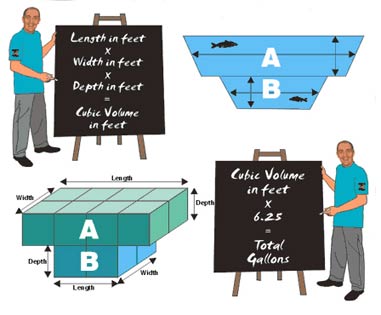How to measure pond water volume
An important prerequisite is that you must calculate the volume of your pond as this will determine the size/capacity of all your ancillary pond equipment i.e. filters, pumps, UV clarifiers and aerators.

| |
The diagram above shows a simple way to assess the volume of an irregular shape by breaking it down into smaller sub units. |
| |
|
| |
In this example the pond has been divided in two main sections A and B. Measure each section in feet. All figures should be rounded UP to the nearest whole foot. For filtration purposes you would be better to over estimate the volume. (This only applies to filtration calculations and NOT for medication. It is GOOD to over filter but BAD to over medicate). The volume of each section is calculated using length x width x depth. This gives us an answer in cubic feet. Each cubic foot holds 6¼ gallons of water. The volumes of the two sections (A & B) should then be added together to give the total cubic capacity. This is multiplied by 6.25 to give the total volume in gallons. |
*NOTE: Take the average depth, which may involve 10 different measurements to give an average pond depth.
Effective pond volume
When selecting the proper size equipment for your pond; actual pond volume alone is not enough, you must determine the effective volume of your pond which is influenced by environmental factors i.e. Is your pond affected by direct exposure to sunlight, shallow depth or climate conditions. If so you may add the following to pond volume.
If average pond water depth is less than 2’6” or 75 cm add 25% as shallow water heats up more and therefore requires more filtration.
Is the pond is located in full sunshine i.e. 6 hours p/d add 25%
or part sunshine 4 - 6 hours add 15%
NOTE: information above does not take into account “fish stocking levels”
Fish stocking densities
An allowance has to be made depending on the kind of fish in your pond e.g. Koi produce more waste than goldfish and therefore require a better filtration system and more attention to detail.
As a rule of thumb: calculate not more than approximately 1 kg of weight of all fish per 1000 litres of water. At a minimum water depth of 80 cm, Koi require 1.5 m of water depth for safe habitat.
